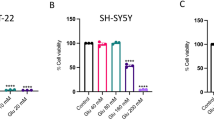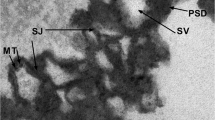Abstract
Brains affected by Alzheimer’s disease (AD) show a large spectrum of mitochondrial alterations at both morphological and genetic level. The causal link between β-amyloid (Aβ) and mitochondrial dysfunction has been established in cellular models of AD. We observed previously that lycopene, a member of the carotenoid family of phytochemicals, could counteract neuronal apoptosis and cell damage induced by Aβ and other neurotoxic substances, and that this neuroprotective action somehow involved the mitochondria. The present study aims to investigate the effects of lycopene on mitochondria in cultured rat cortical neurons exposed to Aβ. It was found that lycopene attenuated Aβ-induced oxidative stress, as evidenced by the decreased intracellular reactive oxygen species generation and mitochondria-derived superoxide production. Additionally, lycopene ameliorated Aβ-induced mitochondrial morphological alteration, opening of the mitochondrial permeability transition pores and the consequent cytochrome c release. Lycopene also improved mitochondrial complex activities and restored ATP levels in Aβ-treated neuron. Furthermore, lycopene prevented mitochondrial DNA damages and improved the protein level of mitochondrial transcription factor A in mitochondria. Those results indicate that lycopene protects mitochondria against Aβ-induced damages, at least in part by inhibiting mitochondrial oxidative stress and improving mitochondrial function. These beneficial effects of lycopene may account for its protection against Aβ-induced neurotoxicity.




Similar content being viewed by others
Abbreviations
- AD:
-
Alzheimer’s disease
- Aβ:
-
β-Amyloid
- ROS:
-
Reactive oxygen species
- mtDNA:
-
Mitochondrial DNA
- mPTP:
-
Mitochondrial permeability transition pores
- DCFH-DA:
-
Dichlorofluorescin diacetate
- NRFU:
-
Normalized relative fluorescence units
- THF:
-
Tetrahydrofuran
- BHT:
-
Butylated hydroxytoluene
- COX I:
-
Cytochrome c oxidase subunit I
- COX IV:
-
Cytochrome c oxidase subunit IV
- ND6:
-
NADH dehydrogenase subunit 6
- GAPDH:
-
Glyceraldehyde-3-phosphate dehydrogenase
References
Zhu X, Perry G, Smith MA, Wang X (2013) Abnormal mitochondrial dynamics in the pathogenesis of Alzheimer’s disease. J Alzheimers Dis 33(Suppl 1):S253–S262. doi:10.3233/JAD-2012-129005
Spuch C, Ortolano S, Navarro C (2012) New insights in the amyloid-beta interaction with mitochondria. J Aging Res 2012:324968. doi:10.1155/2012/324968
Manczak M, Anekonda TS, Henson E, Park BS, Quinn J, Reddy PH (2006) Mitochondria are a direct site of Aβ accumulation in Alzheimer’s disease neurons: implications for free radical generation and oxidative damage in disease progression. Hum Mol Genet 15(9):1437–1449. doi:10.1093/hmg/ddl066
Du H, Yan SS (2010) Mitochondrial permeability transition pore in Alzheimer’s disease: cyclophilin D and amyloid beta. Biochim Biophys Acta 1802(1):198–204. doi:10.1016/j.bbadis.2009.07.005
Pinto M, Pickrell AM, Fukui H, Moraes CT (2013) Mitochondrial DNA damage in a mouse model of Alzheimer’s disease decreases amyloid beta plaque formation. Neurobiol Aging 34(10):2399–2407. doi:10.1016/j.neurobiolaging.2013.04.014
Kujoth GC, Hiona A, Pugh TD, Someya S, Panzer K, Wohlgemuth SE, Hofer T, Seo AY, Sullivan R, Jobling WA, Morrow JD, Van Remmen H, Sedivy JM, Yamasoba T, Tanokura M, Weindruch R, Leeuwenburgh C, Prolla TA (2005) Mitochondrial DNA mutations, oxidative stress, and apoptosis in mammalian aging. Science 309(5733):481–484. doi:10.1126/science.1112125
Sandhir R, Mehrotra A, Kamboj SS (2010) Lycopene prevents 3-nitropropionic acid-induced mitochondrial oxidative stress and dysfunctions in nervous system. Neurochem Int 57(5):579–587. doi:10.1016/j.neuint.2010.07.005
Kaur H, Chauhan S, Sandhir R (2011) Protective effect of lycopene on oxidative stress and cognitive decline in rotenone induced model of Parkinson’s disease. Neurochem Res 36(8):1435–1443. doi:10.1007/s11064-011-0469-3
Prema A, Janakiraman U, Manivasagam T, Thenmozhi AJ (2015) Neuroprotective effect of lycopene against MPTP induced experimental Parkinson’s disease in mice. Neurosci Lett 599:12–19. doi:10.1016/j.neulet.2015.05.024
Yi F, He X, Wang D (2013) Lycopene protects against MPP(+)-induced cytotoxicity by maintaining mitochondrial function in SH-SY5Y cells. Neurochem Res 38(8):1747–1757. doi:10.1007/s11064-013-1079-z
Fujita K, Yoshimoto N, Kato T, Imada H, Matsumoto G, Inakuma T, Nagata Y, Miyachi E (2013) Lycopene inhibits ischemia/reperfusion-induced neuronal apoptosis in gerbil hippocampal tissue. Neurochem Res 38(3):461–469. doi:10.1007/s11064-012-0952-5
Min JY, Min KB (2014) Serum lycopene, lutein and zeaxanthin, and the risk of Alzheimer’s disease mortality in older adults. Dement Geriatr Cognit Disord 37(3–4):246–256. doi:10.1159/000356486
Sachdeva AK, Chopra K (2015) Lycopene abrogates Abeta(1–42)-mediated neuroinflammatory cascade in an experimental model of Alzheimer’s disease. J Nutr Biochem 26(7):736–744. doi:10.1016/j.jnutbio.2015.01.012
Prakash A, Kumar A (2014) Implicating the role of lycopene in restoration of mitochondrial enzymes and BDNF levels in beta-amyloid induced Alzheimers disease. Eur J Pharmacol 741:104–111. doi:10.1016/j.ejphar.2014.07.036
Qu M, Zhou Z, Chen C, Li M, Pei L, Chu F, Yang J, Wang Y, Li L, Liu C, Zhang L, Zhang G, Yu Z, Wang D (2011) Lycopene protects against trimethyltin-induced neurotoxicity in primary cultured rat hippocampal neurons by inhibiting the mitochondrial apoptotic pathway. Neurochem Int 59(8):1095–1103. doi:10.1016/j.neuint.2011.10.005
Qu M, Nan X, Gao Z, Guo B, Liu B, Chen Z (2013) Protective effects of lycopene against methylmercury-induced neurotoxicity in cultured rat cerebellar granule neurons. Brain Res 1540:92–102. doi:10.1016/j.brainres.2013.10.005
Qu M, Li L, Chen C, Li M, Pei L, Chu F, Yang J, Yu Z, Wang D, Zhou Z (2011) Protective effects of lycopene against amyloid beta-induced neurotoxicity in cultured rat cortical neurons. Neurosci Lett 505(3):286–290. doi:10.1016/j.neulet.2011.10.048
Xu S, Zhong M, Zhang L, Wang Y, Zhou Z, Hao Y, Zhang W, Yang X, Wei A, Pei L, Yu Z (2009) Overexpression of Tfam protects mitochondria against beta-amyloid-induced oxidative damage in SH-SY5Y cells. FEBS J 276(14):3800–3809. doi:10.1111/j.1742-4658.2009.07094.x
Bhat AH, Dar KB, Anees S, Zargar MA, Masood A, Sofi MA, Ganie SA (2015) Oxidative stress, mitochondrial dysfunction and neurodegenerative diseases; a mechanistic insight. Biomed Pharmacother 74:101–110. doi:10.1016/j.biopha.2015.07.025
Lustbader JW, Cirilli M, Lin C, Xu HW, Takuma K, Wang N, Caspersen C, Chen X, Pollak S, Chaney M, Trinchese F, Liu S, Gunn-Moore F, Lue LF, Walker DG, Kuppusamy P, Zewier ZL, Arancio O, Stern D, Yan SS, Wu H (2004) ABAD directly links Abeta to mitochondrial toxicity in Alzheimer’s disease. Science 304(5669):448–452. doi:10.1126/science.1091230
Hureau C, Faller P (2009) Abeta-mediated ROS production by Cu ions: structural insights, mechanisms and relevance to Alzheimer’s disease. Biochimie 91(10):1212–1217. doi:10.1016/j.biochi.2009.03.013
Parks JK, Smith TS, Trimmer PA, Bennett JP, Parker WD (2001) Neurotoxic Aβ peptides increase oxidative stress in vivo through NMDA-receptor and nitric-oxide-synthase mechanisms, and inhibit complex IV activity and induce a mitochondrial permeability transition in vitro. J Neurochem 76(4):1050–1056. doi:10.1046/j.1471-4159.2001.00112.x
Casley CS, Canevari L, Land JM, Clark JB, Sharpe MA (2002) Beta-amyloid inhibits integrated mitochondrial respiration and key enzyme activities. J Neurochem 80(1):91–100
Zhang Q, Yu J-T, Wang P, Chen W, Wu Z-C, Jiang H, Tan L (2011) Mitochondrial transcription factor A (TFAM) polymorphisms and risk of late-onset Alzheimer’s disease in Han Chinese. Brain Res 1368:355–360. doi:10.1016/j.brainres.2010.10.074
Butterfield DA, Drake J, Pocernich C, Castegna A (2001) Evidence of oxidative damage in Alzheimer’s disease brain: central role for amyloid beta-peptide. Trends Mol Med 7(12):548–554
Rizwan M, Rodriguez-Blanco I, Harbottle A, Birch-Machin MA, Watson RE, Rhodes LE (2011) Tomato paste rich in lycopene protects against cutaneous photodamage in humans in vivo: a randomized controlled trial. Br J Dermatol 164(1):154–162. doi:10.1111/j.1365-2133.2010.10057.x
Hong WK, Han EH, Kim DG, Ahn JY, Park JS, Han BG (2007) Amyloid-beta-peptide reduces the expression level of mitochondrial cytochrome oxidase subunits. Neurochem Res 32(9):1483–1488. doi:10.1007/s11064-007-9336-7
Yue R, Xia X, Jiang J, Yang D, Han Y, Chen X, Cai Y, Li L, Wang WE, Zeng C (2015) Mitochondrial DNA oxidative damage contributes to cardiomyocyte ischemia/reperfusion-injury in rats: cardioprotective role of lycopene. J Cell Physiol 230(9):2128–2141. doi:10.1002/jcp.24941
Choi H, Lee DG (2015) Lycopene induces apoptosis in Candida albicans through reactive oxygen species production and mitochondrial dysfunction. Biochimie 115:108–115. doi:10.1016/j.biochi.2015.05.009
Acknowledgments
We are particularly grateful to Dr. Fanzheng Yang (Central university of Finance and Economics) for her critical review and valuable suggestions that improved the quality of this manuscript.
Author information
Authors and Affiliations
Corresponding author
Ethics declarations
Conflict of interest
The authors declare that they have no conflict of interest.
Additional information
Mingyue Qu and Zheng Jiang contributed equally to this work.
Rights and permissions
About this article
Cite this article
Qu, M., Jiang, Z., Liao, Y. et al. Lycopene Prevents Amyloid [Beta]-Induced Mitochondrial Oxidative Stress and Dysfunctions in Cultured Rat Cortical Neurons. Neurochem Res 41, 1354–1364 (2016). https://doi.org/10.1007/s11064-016-1837-9
Received:
Revised:
Accepted:
Published:
Issue Date:
DOI: https://doi.org/10.1007/s11064-016-1837-9




